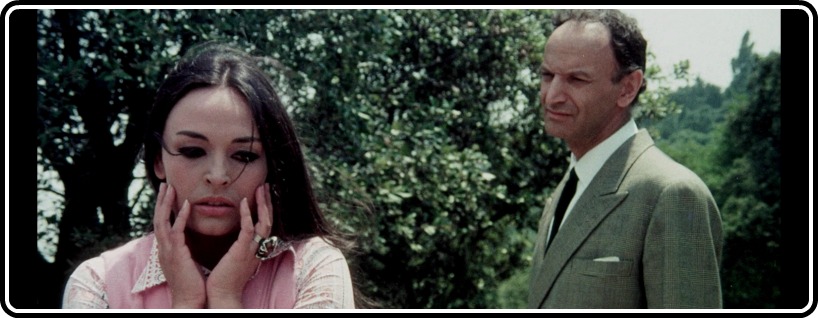When you make as many films as director Jess Franco had before his death a year or so ago, one or two are bound to become “lost.” However, the sheer quantity of films from Franco doesn’t make a discovery like Nightmares Come At Night any less entrancing.
Having played in simply one Belgian theater, Nightmares has since been thought of as a “lost” Franco picture, until now. Kino Lorber bunk buddy Redemption Films has brought the film to Blu-ray for the first time, and with a new restoration based on an archival print found back in 2004, this new release is a superb look at one of Jess Franco’s most interesting pictures.
Starring Franco-staple Diana Lorys, the film follows the story of a dancer, Anna, who lives with the evil Cynthia, a woman hell bent on controlling everything Anna does. Anna however does have an outlet to vent, one Dr. Paul Lucas, but structured along with the story of a pair of jewel thieves living in a house nearby, the film itself becomes an example of Franco, the filmmaker, at his very best and his very worst.
At its very best the film is a breathtaking bit of erotic experimentation. The film is a slow burn if Franco ever made one, and the photography here is utterly breathtaking. From the opening title sequence you are introduced to a film that is heightened in just about every possible way. Relatively standard stuff when coming from Franco, but for the uninitiated, this will come as a brazen shocker that will be hard to forget.
And at its worst its nearly incomprehensible. The structure here is so lacking that much of the plot doesn’t truly unfurl until about an hour in, making the pacing feel far too back end heavy, and finding very little for the viewer to inherently get interested in. The performances are rather broad and sweeping, touching more on moods than anything remotely resembling actual character work, even the beautiful Lorys is often times wooden and stagnant performance-wise. The viewer feels constantly at arm’s length from the character, no matter how intimate any given sequence may seem. Even the nude scenes hold very little interest for the viewer, outside of mere aesthetic intrigue. There is some weaving together of the narrative in that aforementioned final act, and some performances do come alive (Paul Muller again feels like the most interesting part of yet another Franco picture), but narrative is far and away from Franco’s mind when it comes to this film.
And yet, it’s oddly entrancing. The film is so entrancing visually, that while the film’s narrative, performances and ultimately the themes (of which this film really doesn’t hold much stock in either) are so limp wristed, it becomes something nearly impossible to turn off. Hypnotic has been a descriptor attached to this film before, and it is absolutely fitting because it lulls one to sleep, but only due to the lack of any real narrative. The viewer becomes so deeply engrossed in the film’s aesthetic and Franco’s aesthetic choices that it becomes an entirely cinematic experience. Instead of attempting to tell a story through anything remotely resembling a narrative, the film is told almost entirely through style and atmosphere, proving to be one of Franco’s most singular and truly interesting, while ultimately weakest, motion pictures.
Kino’s new Blu-ray is thankfully more than stacked, to make up for the middling level of this actual film. The transfer is shockingly good given its previously “lost” status, and the Tim Lucas commentary is, as expected, dense, interesting and ultimately a joy to listen to. There is a 20 minute making of documentary, a video essay on the making of the master for this film, and also an homage to Franco from Daniel Gouyette, which joins all three of Kino’s new Blu-ray releases. Overall, while the film is ultimately a minor work in Franco’s canon, this Blu-ray is a must own for fans of the legendary genre auteur.






![Bergman Island (The Criterion Collection) [Blu-ray]](https://criterioncast.com/wp-content/uploads/2022/11/bergman-island-the-criterion-collection-blu-ray-400x496.jpg)
![This Is Not a Burial, It’s a Resurrection (The Criterion Collection) [Blu-ray]](https://criterioncast.com/wp-content/uploads/2022/11/this-is-not-a-burial-its-a-resurrection-the-criterion-collection-blu-ray-400x496.jpg)
![Lars von Trier's Europe Trilogy (The Criterion Collection) [The Element of Crime/Epidemic/Europa] [Blu-ray]](https://criterioncast.com/wp-content/uploads/2022/11/lars-von-triers-europe-trilogy-the-criterion-collection-the-element-of-400x496.jpg)
![Imitation of Life (The Criterion Collection) [Blu-ray]](https://criterioncast.com/wp-content/uploads/2022/11/imitation-of-life-the-criterion-collection-blu-ray-400x496.jpg)
![The Adventures of Baron Munchausen (The Criterion Collection) [4K UHD]](https://criterioncast.com/wp-content/uploads/2022/11/the-adventures-of-baron-munchausen-the-criterion-collection-4k-uhd-400x496.jpg)
![Cooley High [Criterion Collection] [Blu-ray] [1975]](https://criterioncast.com/wp-content/uploads/2022/11/cooley-high-criterion-collection-blu-ray-1975-400x496.jpg)